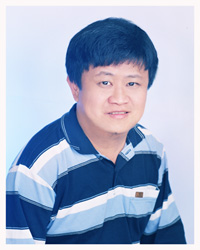管傑雄 Chieh-Hsiung Kuan
主要研究領域:
光電元件、奈米電子、電子束微影技術Major Research Areas:
Optoelectronic Device, Nano-Electronics, E-Beam lithography technology研究領域摘要:
(1) 我們建立起一套完整的雜訊測量系統。整套系統成功的原因是在於自行設計的放大器及量測雜訊的方法,使雜訊量測更趨準確
(2) 更以測量光電流雜訊的方式來得知電子或電洞的nonradiative lifetime,而測量準確度可達數十nanosec,並實驗證明Shockley Read Hall recombination theory的正確性 。
(3) 成功發展超晶格紅外線偵測器,其偵測度媲美量子井紅外線偵測器,且具有低功率消耗,低跨壓等優點。此種結構可當作Two-color紅外線偵測器。將該偵測器應用在遙測溫度,可遙測溫度範圍是350K~1000K。
(4) 疊加兩種不同的超晶格並適當設計更進一步地改良設計兩超晶格之間的阻礙能障,我們成功地發展出特性更佳的Four-color偵測器,此種多彩偵測器,其光譜響應不受元件溫度的影響,而且偵測波段是用電壓極性來改變,在同一波段的響應光譜也可用電壓大小來調變。此項設計為2002年六月份Laser Focus World引用為Newsbreak。
(5) 物理機制的理解將有助於元件的設計。我們發現超晶格偵測器是利用電子的group velocity,而非多重量子井中所利用的電子drift velocity。此項結果使得兩者的設計理念完全不同。
(6)電子束微影技術基於電子及光電半導體製程技術而發展出之奈米級高性能元件設備,在優良工作環境下 可達十奈米線寬製作之要求;並期能將元件整合於超大型積體電路中,使兼具元件縮小化及高整合性之雙重功能。應用範圍涵蓋電子、光電、物理、化學、生物及微機電等領域。
Research Summary:
(1) We developed a noise measurement system.The success of the system is attributed to the current amplifier and the method of noise measurement designed by our group to improve the measurement accuracy.
(2) The nonradiative lifetime of the electrons and holes in the semiconductor can be measured with the photocurrent noise. We utilized this concept to confirm the Schockley Read Hall recombination theory with experiments and demonstrated the smallest lifetime the system could measure was about ~10 nanoseconds.
(3) The superlattice infrared photodetector was successfully designed and demonstrated. The associated detectivity is compatible with the conventional quantum well infrared photodetector. The primary advantage is low-power dissipation and low bias voltage . The detector can be utilized to sense the practical temperature of the remote object. The experiment demonstrates the remotely-sensing temperature range is 350~1000K.
(4) Stacking two different superlattices and inserting an appropriate blocking barrier, we successfully developed the four-color infrared photodetector with much better performance. The detector performance of independent of the operating temperature. The detected wavelength range can be switched by the bias polarity and the spectral response in one wavelength range can be tuned by the bias magnitude. The result is cited as a newsbreak in the June issue of Laser Focus World 2002.
(5) Understanding the physical mechanisms is helpful to the device design. It is found that the group velocity of the electrons in the miniband of the superlattice structure is a key factor to design the detector. This result is wholly different from the drift velocity of electrons used in the conventional quantum well infrared photodetector . It also renders a different design principle.
(6)The electronic beam system ELS7500 and ELS7000 can develop nano-scale-high-performance device. In optical circumstances, the system can make a device that reaches 10 nano-meter line width and minimize the device. We expect the device can be integrated into VLSI systems.

-
B.S.
National Taiwan University, 1985 -
M.S.
Princeton University, 1989 -
Ph.D.
Princeton University, 1994
-
Address
BL-513,
Department of Electrical Engineering,
National Taiwan University,
Taipei 106, Taiwan -
Phone
+886-2-33663569 -
FAX
+886-2-23681679 -
Email:

-
Personal Homepage
http://cc.ee.ntu.edu.tw/~kuan/